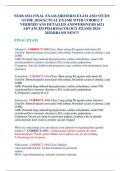NURS 6521 FINAL EXAM,MIDTERM EXAM AND STUDY
GUIDE 2024/ACTUAL EXAMS WITH CORRECT
VERIFIED ANS DETAILED ANSWERS/NURS 6521
ADVANCED PHARMACOLOGY EXAMS 2024-
2025/BRAND NEW!!!
FINAL EXAM
Albuterol - CORRECT ANS-Class: Short acting B2 agonist with minor B1
Used for: Bronchospasms associated with asthma, bronchitis (acute or chronic), and
COPD
ADR: Potential drug-induced hyperglycemia, cardiac arrhythmias, some CNS
excitationeffects (tremors, dizziness), HA, tachycardia, palpitations
Comments: Safe for children and pregnancy; may combine with ipratropium; least
expensive
Terbutaline - CORRECT ANS-Class: Short acting B2 agonist with minor B1
Used for: Bronchospasms associated with asthma, bronchitis (acute or chronic), and
COPD
ADR: Potential drug-induced hyperglycemia, cardiac arrhythmias, some CNS
excitationeffects (tremors, dizziness), HA, tachycardia, palpitations
X: Pregnancy category B or C
Salmeterol - CORRECT ANS-Class: Long acting B2 agonist, more selective
Used for: Bronchospasms associated with asthma, bronchitis (acute or chronic), and
COPD
ADR: Potential drug-induced hyperglycemia, cardiac arrhythmias, some CNS
excitationeffects (tremors, dizziness), HA, tachycardia, palpitations
Comments: Do not use alone for persistent asthma, combine with an inhaled
corticosteroid; don't wash it, powder can get clogged
What are some things you can educate your patients on regarding beta agonist
inhalers? - CORRECT ANS-1. Demonstrate and have patient do return
demonstration2. Check correct inhaler use if patient says it's not working
3. Encourage use of spacer
Fluticasone - CORRECT ANS-Class: Inhaled
corticosteroidUsed for: 1st line treatment for persistent
asthma
MOA: Anti-inflammatory, minimal systemic exposure
,Budesonide - CORRECT ANS-Class: Inhaled
corticosteroidUsed for: 1st line treatment for persistent
asthma
MOA: Anti-inflammatory, minimal systemic exposure
Zafirlukast - CORRECT ANS-Class: Leukotriene
modifier/antagonist Used for: 2nd line to decrease
bronchoconstriction, edema
MOA: Works similar to prostaglandins in r/t to inflammation, blocks lipoxygenase
Theophylline - CORRECT ANS-Class: Xanthine;
stimulant Used for: Asthma
MOA: Bronchial smooth muscle relaxation
ADR: cardiovascular effects, increased gastric acid production, CNS effects
(irritability, restlessness, seizures, insomnia), GI effects (reflux, worsens heartburn),
cardiac effects(palpitations, tachycardia, hypotension, life-threatening arrhythmias)
X: GERD, HTN, ischemic heart dx, coronary insufficiency, CHF, history of
stroke,cardiac arrhythmias; smoking increases clearance
Comments: Stay away from charcoal-broiled foods (accelerates the hepatic
metabolism), avoid large amounts of caffeine containing beverages; elimination
isinfluenced by diet
What are the signs of Theophylline toxicity? - CORRECT ANS-Vomiting,
insomnia,jitteriness, HA, severe GI pain, irregular heartbeat
Ipratropium Bromide - CORRECT ANS-Class: Inhaled
anticholinergicUsed for: NOT 1st line, supplemental use in acute
bronchospasm
MOA: Blocks the muscarinic cholinergic receptors, causes bronchial smooth muscle
relaxation; uses alternate pathway, effects additive with beta receptors
What is asthma? - CORRECT ANS-Chronic inflammatory disorder of the airways,
recurrent episodes of wheezing, breathlessness and chest tightness, airflow
obstructionis reversible - recommendations by Expert Panel III is to take an
aggressive approach to gain quick control
What would you treat mild intermittent asthma with? - CORRECT ANS-Step 1
therapy: 1. Use short acting B2 agonists PRN for symptoms - patients may have
symptoms when exposed to triggers (URI, allergens, chemical inhalents,
exercise)
2. Educate on annual flu shot
,What would you treat mild persistent asthma with? - CORRECT ANS-Step 2
therapy: 1. Long-term/low dose inhaled corticosteroids such as Fluticasone or
Budesonide 2. Use short acting B2 agonist PRN, if using more than 2
days/week, then step up therapy
What would you treat moderate persistent asthma with? - CORRECT ANS-Step
3therapy:
1. Treat with medium dose inhaled corticosteroids (Fluticasone or Budesonide)
OR 1. Low dose inhaled steroid (Fluticasone or Budesonide) plus long acting
B2 agonist(Advair or Salmeterol) OR
1. Medium dose inhaled steroid (Fluticasone or Budesonide) plus leukotriene
receptorantagonist (Zafirlukast)
2. May use short acting B2 agonists (Albuterol or Terbutaline)
What would you treat severe persistent asthma with? - CORRECT ANS-Step 4
therapy:
1. Medium dose inhaled corticosteroid (Fluticasone or Budesonide) AND long-
acting B2agonist (Salmeterol) OR
1. Medium dose inhaled corticosteroid (Fluticasone or Budesonide) AND a
leukotrienemodifier (Zafirlukast) OR Theophylline
Step 5 therapy:
1. High dose inhaled corticosteroid AND long acting B2 agonist
Step 6 therapy:
1. High dose inhaled corticosteroid AND long acting B2 agonist AND oral
corticosteroid
**Severe persistent asthma requires consultation with asthma specialist
What drugs would you consider for pregnant patients who have asthma? -
CORRECT ANS-Inhaled beta agonists are acute drug of choice; inhaled
corticosteroids are thelong term drug of choice
When would you refer a child with asthma to a specialist? - CORRECT ANS-At
step 3therapy
When would you consider using a long acting B2 agonists as monotherapy? -
CORRECT ANS-If your patient has COPD
, Systematic antibiotics are required for ? - CORRECT ANS-Moderate to
severe impetigo, boils, abscesses, perianal strep, cellulitis, MRSA suspected
skin infections
Mupirocin - CORRECT ANS-Class: Topical
ATB Used for: Mild impetigo, nasal MRSA
carriers Comments: Generic Mupirocin is
less expensive
Bacitracin - CORRECT ANS-Class: Topical
ATBUsed for: Mild impetigo
Comments: Can be combined to make double or triple ATB
Retapamulin - CORRECT ANS-Class: Topical
ATBUsed for: Mild impetigo or nasal MRSA
carriers
Comments: Cannot be given intranasal or will destroy sense of smell
Polymixin B - CORRECT ANS-Class:
Topical ATBUsed for: Mild impetigo
Comments: A double and triple ATB
Neomycin - CORRECT ANS-Class: Topical
ATBUsed for: Mild impetigo
Comments: May cause sensitivity in triple ATB
Cephalexin - CORRECT ANS-Class: Oral ATB
Used for: Severe impetigo >5 lesions, or if no improvement in 2-3 days,
furuncles, 2ndline for UTI, therapeutic failure of AOM
MOA: Inhibits CELL WALL
ADR: Diarrhea; don't take if allergic to PCNs
Amoxicillin/Clavulanate - CORRECT ANS-Class: Oral ATB
Used for: Severe impetigo >5 lesions, or if no improvement in 2-3 days, furuncles,
infection f/b human bites, AOM (if fever >39C and/or severe otalgia)
MOA: Inhibits CELL WALL
Clindamycin - CORRECT ANS-Class: Oral or topical ATB
Used for: 1st line for MRSA, AOM treatment failure (if allergy to Augmentin or
Amoxicillin), acne, infections in PCN allergies, DSRP, dental infections, 1st line
forpregnancy and children, 2nd line for narrow spectrum of aerobic activity
MOA: Inhibits PROTEIN SYNTHESIS




